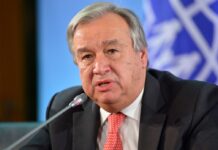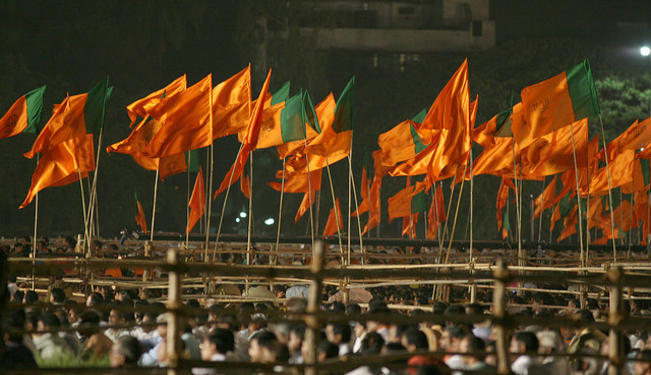In a startling statement, the Uttar Pradesh police have revealed that they had seized cash, gold and drugs worth Rs 110 million ahead of the second phase of the UP elections in India. Besides, they also recovered 2053 illegal arms, ,835 cartridges and 165 kg of explosives. Preventive action has been taken against 440,000 hooligans likely to disrupt the peace.
India’s Representation of Peoples Act forbids politicians from possessing, distributing or transporting illegal cash, narcotics, drugs, liquor, gold and silver and a host of freebies and gifts among people to lure them to vote in their favour. Yet,the 2014 and 2019 Lok Sabha elections saw biggest seizures of drugs, cash, liquor and so on to date.
Enforcement agencies let the offenders slip off with a slap on wrist. The election commission keeps issuing clean chits for all sorts of violations.
About Rs 3 billion in cash was seized during the 2014 Lok Sabha election. This excludes 1, 61, 84,508 litres of liquor and 17,070 kg of drugs and narcotics seized from different parts of the country.
The Western notion of democracy maintains, among other things, an analytical distinction between formal democracy, which India fulfils with regular elections, and substantive democracy whose sine qua non are a corruption-free society, elimination of iniquities and human-rights violations.
Thus, repeated elections are no real test of a democracy. Money plays an important part in determining a poor voter’s electoral choice. Elections are marred by anti-democratic features like violence, en bloc voting, voting along religious and caste lines, and so on.
The central and state governments in India do not necessarily represent rule by a majority. Through coalition politics a party with less than 50 percent votes can form the government at the centre or in states. There are several ways to determine the majority in an electoral system. In India’s system, whoever gets the largest number of votes is elected.
The multiparty system allows not only a plethora of political parties, but also individuals to contest elections. If votes get divided among different contestants in a constituency, a candidate with less than 50 percent votes can win. To avoid this situation, some countries require that a candidate should get 50 percent of the votes cast to be declared a winner.
Caste influence has always been predominant in secular India. The social structure and equipoise of the traditional polity legitimized ‘the power and control of land-based jatis (castes) over a disaggregated and alienated mass of the landless, the bonded labourers, low castes and sudras’.
India, the world’s largest democracy, stands divided into two worlds, the affluent and the poor. Half of India’s population lives below the poverty line ($1 or $2 a day). The poor are prone to be influenced by cash doles, booze, and freebies. Money plays an important part in determining a poor voter’s electoral choice. Historically, the richer party wins.
Ever since independence, the politicians made no serious effort to reduce the influence of caste on elections. They continued to hoodwink masses with buzzword-subsumed themes of ‘removal of poverty, illiteracy and disease by bridging the gulf between the rich and the poor, between the urban and rural, through industrialization, spread of education and building of an egalitarian-cum welfare state’. The slogans brought no change in the condition of scheduled tribes (girijans), scheduled castes (harijans), castes (jatis), religious communities (dharmic sampratya) and language communities (bhashai sampratya).
Nobel laureate Amartya Sen, in a lecture on “Democracy and its Critics”on 16 December 2005, said, “The rise of caste-ist politics was a failure”.
Stephen P. Cohen points to ‘slow expansion of military influence within the Indian political system’, ‘institutional anomaly of caste-based units recruited on a “martial races” basis, ‘the great social distance between officer and jawan (soldier)’ even when from the same class background. Cohen regards the army’s expanded role in governing states as a ‘challenge to democratic values’. He expresses disgust at ‘forty million Indians living under military rule, if not military law, making India one of the world’s largest military-dominated states while it was simultaneously the world’s largest democracy’. Cohen also refers to ‘the bypassing of the para-military forces in quelling riots, irregularities in senior promotions, controversy over caste recruitment to the army’.
Honest men like even Acharya Narendra (the doyen of Indian socialism) and Acharya Kirplani got rejected at the hustings. The people have now realised that repeated elections are no real test of a democracy. India’s democracy accepts the right of cheats and bullies to rule.
Corporate contributions, up to five percent of a company’s net profits, to political parties are legal. Huge funds are collected from individuals and companies by extortion or for past or future favours.
Political corruption has become integral to India’s governance process. The disclosure norms are very feeble and un-enforced. Most expenditure is illegitimate, going on buying votes, distributing liquor, transporting voters, bribing local powerbrokers, bribing polling agents, payoffs to police and polling personnel in several places and hiring hoodlums for rigging and booth capturing.
Most major parties no longer attract voluntary party workers motivated by principles and goals. They hire workers at great expense during elections. Large mobilisation of poor people for election meetings, spending enormous sums for lorries, and bribes to hired audiences, and ostentatious campaign in the form of large fleets of cars and jeeps, huge cut-outs, banners, posters, tents, and loudspeakers account for other expenditures.
According to the Association for Democratic Reforms, a record 43 percent of MPs elected in 2019 had been charged with a crime, with 29 percent booked for grave offences like rape and murder, 109 percent up over ten years earlier.
Crime seems to pay: analysis shows that a candidate with a criminal record is three times more likely to win than one without. Similarly, one with declared assets of more than Rs 50 million is six times more likely to succeed than one with less.
Donations were introduced in 2018, ostensibly as a reform to weed out illicit cash. This allows for unlimited, opaque financing of political parties. It is nearly impossible to trace links between a billionaire whose fortune ballooned after securing lucrative deals from the government, and his or her donations to enabling politicians. The sole indicator of political funding now disclosed is the total amount received. In 2020 the BJP’s declared assets of $655m surpassed those of the next 51 political parties combined. More striking, its wealth rose by 443 percent in just five years.
Some 814 million voters speaking 1,652 languages voted in 900,000 voting centres across India over 35 days in 2019. This cost parties a flabbergasting Rs 300 billion.
Individual candidates can spend only Rs7 million on their campaigns. This is too little to meet even poster printing costs in important contests. Key candidates spend between Rs 750 million to Rs 3 billion. Lesser stars spend between Rs150 to 500 million and marginal candidates between Rs10-100 million.
Mammoth rallies where half a million people cheer candidates cost upwards of Rs 30 million. Every major party holds at least one major rally or counter-rallies a day. Add the cost of sending thousands of workers out in cars, trains, planes, rickshaws, bicycles, bullock carts, tractors, camels, horses, and boats to woo voters with speeches, street plays, and songs.
Persecution of religious minorities and the so-called untouchables (who prefer to call themselves dalits) is endemic to the social and cultural systems that circumscribe the Indian polity. A four-year-old girl, named Surjo, was boiled in a tub in Muzaffarnagar, UP, and then beheaded to please gods as part of a religious sacrifice.
In a country where sons are sold for 25 paisas and women are thrown into the fire to please Sati, goddess of chastity, such events cannot be foreseen or forestalled. The solution lies in state funding of elections. Reforms suggested in Tarkunde Committee, Indrajit Gupta Committee, Dinesh Goswami Committee and N. S. Gehlot could not be implemented.
Hindutva supporters want to convert India into a centralised state for the Brahmans only. The rise of the BJP from a marginal Hindu nationalist party of the 1980s to the majority party in parliament in 1999 vindicates the ascendancy of the Hindutva trend. Obviously, India is the largest democracy in form but not in substance.
India, the world’s largest democracy, stands divided into two worlds, the affluent and the poor. Half of India’s population lives below the poverty line ($1 or $2 a day). The poor are prone to be influenced by cash doles, booze, and freebies. Money plays an important part in determining a poor voter’s electoral choice. Historically, the richer party wins.
Bulk of money goes to media advertising. The BJP spent over one-third of its funds on advertising. Political parties shun paupers and nominate candidates with hefty wallets.






















